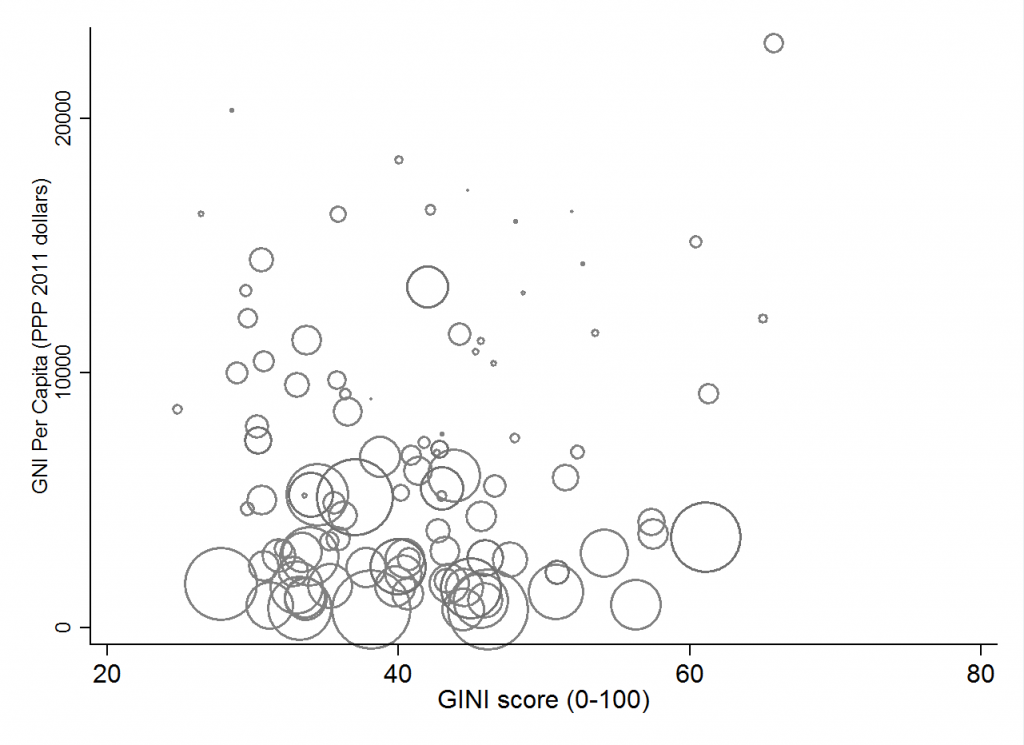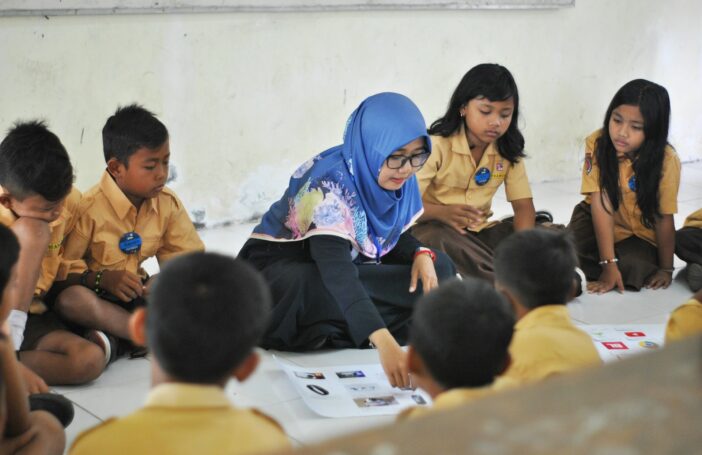Is economic inequality important for aid work? This was the question I asked myself when I saw the name of this year’s ACFID University Network Conference: “Evidence and Practice in an Age of Inequality”. (The title didn’t specifically mention economic inequality, but conference material suggested it was the topic at hand.) It was an interesting theme; yet as I mulled it over I couldn’t convince myself that economic inequality ought to be high on the list of issues aid workers anguish about.
That’s not to say I think economic inequality is a good thing. As a utilitarian who believes the evidence showing that when you are poor more money improves your well-being considerably, but that when you are wealthy more money makes little difference, I think unnecessary inequality is bad.
But this doesn’t mean economic inequality is necessarily something aid practitioners should be worrying about a lot in their day jobs. For this to be true we need evidence that actively tackling inequality in developing countries is of central importance in increasing the wealth (and therefore well-being) of poor people. We also need evidence aid is likely to be a powerful instrument in tackling economic inequality. And, because our money, time and ideas are finite, we need cause to believe reducing economic inequality is more important than all the other things we could be working on, or worrying about.
There is good evidence poorer countries are, on average, home to lower levels of well-being. And we live in a very unequal world which, if it were to become more equal by virtue of its poorest people becoming wealthier, would be a better place. But the core problem here isn’t that the world’s poorer countries are particularly unequal; the problem is that poor countries are poor. Which means that if we want to reduce economic inequality globally and, through this, increase well-being, economic development is needed.
Of course, it’s best if, as economies grow, they reduce inequality too, but for poor countries, overall wealth is more important than issues of distribution. True, some aid-recipient countries are both comparatively wealthy and also very unequal (for example, Brazil), and in these countries reducing economic inequality has considerable scope for reducing poverty. However, this is where the question of aid’s potential influence is important. In countries where reducing inequality can significantly help in reducing poverty, is it reasonable to expect aid to have much influence on inequality? In the chart below I’ve plotted national wealth (GNI per capita) on the Y-axis versus inequality on the X-axis (measured by the GINI coefficient). Each circle is an aid recipient country. Countries in the top right of the chart (unequal and comparatively wealthy) are countries that have the most potential to tackle poverty through reducing inequality. To capture the potential influence of aid I have scaled the size of each country circle to reflect aid as a percentage of GNI. (Data sources and notes can be found on page 8 of this PDF.)
Figure 1: GNI per capita versus GINI score for aid recipient countries
 Some unequal and comparatively wealthy countries receive aid. But the bulk of countries where aid might reasonably be assumed to have potential economic influence (the larger circles) are down the bottom of the chart: countries where growth is a more important condition for reducing poverty and improving well-being.
Some unequal and comparatively wealthy countries receive aid. But the bulk of countries where aid might reasonably be assumed to have potential economic influence (the larger circles) are down the bottom of the chart: countries where growth is a more important condition for reducing poverty and improving well-being.
To be clear, this doesn’t mean aid should focus on fostering economic growth alone. While there’s a relationship between wealth and well-being, other things matter, and it isn’t clear that aid is particularly effective in boosting economic growth in some contexts (this is something I cover in this paper, and these blog posts). Aid should focus on economic development when it can do so productively, but focus on other areas (health, empowering women, promoting political participation, etc.) in contexts where it can deliver more in these areas.
Ultimately, something similar strikes me as true with economic inequality, and whether we should worry about it in aid work. Economic inequality is an issue, but it is not the only economic issue that matters. It’s also the case that economic inequality isn’t the only form of inequality confronting aid work. And other types of inequality are often more central to aid practice.
Think about gender inequality: domestic violence rates are abysmal in Pacific countries such as Solomon Islands while women’s political representation is very low across the Pacific (see page 3 of this PDF). Or to give another example of particular relevance to the work of the Australian aid community, in one fell swoop Joe Hockey was able to cut Australian aid by 20 per cent. Here we have a form of acute political inequality: one man can make a decision that will potentially affect the lives of hundreds of thousands of people who can’t vote in Australia, and justify it with spurious arguments; and the Australian aid community has yet to find an effective way of countering this. This isn’t for want of trying, people are campaigning against the cuts, but it’s not easy. Likewise, enduring gender inequalities in the Pacific continue in spite of our efforts to counter them.
Of course, sometimes economic inequality is tangled up with these other types of inequality (one of the problems women face in elections in Solomon Islands is that they don’t have the money male candidates do) but this isn’t always the case (money doesn’t explain domestic violence, and it’s not clear that we’re losing the fight on aid funding because we have too little money to campaign with).
And this is the source of my concerns about aid workers, and academics with an interest in aid, getting too caught up on the issue of economic inequality. It’s not that it doesn’t matter: it does, but the inequalities that matter most for actual aid practice, and the inequalities that we still don’t know enough about tackling aren’t, first and foremost, ones to do with money.
Terence Wood is a Research Fellow at the Development Policy Centre. His PhD focused on Solomon Islands electoral politics. Previously he worked for the New Zealand Government Aid Programme. This blog is based on a presentation given at the 2015 ACFID University Network Conference. You can download the presentation, with speaking notes and charts, and data sources, here.






Hello Terence,
Check out the blog below. It highlights a reason why aid practitioners should be concerned about economic inequality.
http://post2015.org/2015/07/30/how-many-people-were-left-behind-by-unequal-growth-during-the-mdg-period/
Cheers,
Chris
Hi Chris,
Thanks for the link to your interesting analysis and blog post. I agree with the substance of your post: that growth that comes with lower inequality will do a better job in reducing poverty. Indeed, I say as much in my post above.
However, in countries where aid has the greatest potential leverage, (proxied in my post by aid/GNI), which are almost inevitably very poor countries, the foremost economic issue, initially at least, is growing the size of the pie. You effectively show the same in your chart one (see the minimal difference between the two blue bars for LICs under the different scenarios). Even so, even in these countries, I still think economic inequality is an issue that aid practitioners should pay some concern to. However, as I say in my post (my central argument), there are good reasons to think other forms of inequality are more important for aid work in the typical aid recipient country.
Thanks again.
Terence
Terence, the key point that Martin Ravallion made (at the conference and here at the ANU) is that the ‘floor’ (the % of very poor) has not moved much in 20+ years. Now that should be of concern to all aid practitioners as that is about the very large number being left behind (and yes most are women, so gender is a key issue in this).
Hi Patrick,
Thanks for your comment.
My understanding of Ravallion’s floor measure is different from yours. As I understand it, he derives (rather than observes) an estimate of the level of consumption that the least well off person globally (or someone approximating to that person) is consuming. This is the value that has not shifted a lot; however, actual proportion of the world’s population living at very low levels of consumption ($1 a day ; even 50c a day) has fallen markedly in recent decades (to the extent we trust the data, which I think we can to a degree). This is contra to your claim that a “very large number are being left behind”.
You can see the falling share of the World’s population on slides 31 and 32 of Ravallion’s talk. And, philosophically, for a Utilitarian like myself, as opposed to a Rawlsian, this improvement is more important (with a few caveats) than lifting the floor.
Methodologically, I’m still unclear as to how Ravallion can detail a reduction in people living off a consumption level (50c/day) under what he calculates the floor to be (between 47c&87c) and not also see a shift in the floor itself, although I think the issue is hinted at on slide 25 — which illustrates a falling floor even in a world where poverty has decreased. This points, at least to my thinking, to a significant issue in Ravallion’s approach (although I may be missing something, I concede).
Beyond all that, please recall that I am in favour of reducing poverty, and think unnecessary economic inequality a bad thing. I just don’t believe economic inequality is the most important form of inequality aid workers should be worrying about.
Thanks again.
Terence
‘This is contra to your claim that a “very large number are being left behind”’. It all hangs on the definition of ‘very large numbers’. In India, about which I know a little, the numbers are very large despite a reasonable social security system to preserve a ‘floor’. Where we differ is where you say ‘[for] aid work the foremost issue remains one of raising average levels of income’. For many aid workers and organisations (even centre-left political parties) it is about a poverty focus and ‘lifting the floor’. The ‘rising tide does not lift all boats’, contra to the views of centre right political parties.
Large numbers, but getting substantially smaller.
Having said that I concede the point re average income — as I made clear in my post, but possibly not in my comment, distribution does matter.
Have a good weekend.
Hi Terence,
I am aware that there is quite a lot of evidence to suggest that high levels of inequality can lead to conflict over resources. In many countries this is a major factor impacting on development. It’s therefore strange to be arguing that development practitioners should not be concerned about inequality.
The work of David Halpern et al (see: The Spirit Level) also shows that societies that are ‘more equal’ are generally ‘better off’ in terms of well-being.
So I am surprised to see your line of argument.
Roy
Hi Roy,
Thanks for your comment.
I’m not aware of the literature on resource conflict, but beyond that there are four reasons I can think of to be concerned with economic inequality.
1. Diminishing marginal utility to income (which I cover above). This provides compelling reason on its own.
2. That high inequality leads to slower economic growth. There have been some good recent papers on this by the OECD and IMF, suggesting that it does (in certain countries at least) but the evidence is not yet conclusive.
3. Spirit level type arguments that more unequal countries have higher crime, and more violence etc. These findings are still much debated although I find them quite persuasive. However, they apply for the most part (and are based on data from) OECD countries where severe absolute material deprivation is not very minimal.
4. That economic inequality leads to political inequality, which can lead to anti-poor politics.
On 1 & 3 I would say that for aid work the foremost issue remains one of raising average levels of income in poor countries (as per the post).
On 2 I think we need more evidence particularly with respect to countries that receive a lot of aid, before we conclude the issue gives us cause to be concerned.
On 4 and your point about conflict, here we potentially see real issues, but I’m not sure the best way for aid to try and tackle them is to take aim at economic inequality per se but rather to try and address the issues directly (as best we can, if we think it’s possible).
Recall that I’m not saying that economic inequality doesn’t matter, I think it does. But I think it probably isn’t something aid can do a lot about in most instances. And I think there are other forms of inequality which matter more for aid work (most of the time).
Thanks again
Terence
Dr Woods,
First off, I appreciate your breaking away from what seems obvious by questioning certain narratives, no wonder Alisa and Kate are questioning your angle. I agree with them especially as I have experienced economic inequality both as an aid worker of sorts and LDCs resident. In agreeing with your doc, economic inequality should not be a priority earmarked for fixing as its explanation is more correlational than rooted in causality reasons such access to education or unbiased distribution of public goods.
Thanks
Thank you Jules,
I think your last point is a good one. And I’d say that even where there is a relationship (almost always a complicated one) between economic inequality and other development issues we care about we need to think carefully about how we go about tackling the issue in question. It may be the case that it has to be tackled by addressing economic inequality, but quite possibly the best point of entry is though one of the other related variables.
Terence
I’m wildly unenthusiastic about your sweeping definition of aid practitioners. For many of us, it is EXACTLY our job to worry about economic growth, inequality, and the impact of both on the lives of the poor. Perhaps you really mean community workers (although I’d question this too), or humanitarian workers? But “aid practitioners” is a broad church, and I for one take economic inequality very seriously on a daily basis.
Hi Alsia,
Thanks for your comment. Out of interest, how would you define an aid practitioner?
My definition would be someone who works for an aid NGO, an aid contracting firm, or a government aid agency. As well as academics whose work focuses foremost on issues of improving human welfare in poorer countries.
For the people in my list, I would argue (as I’ve done in the blog post above) that economic inequality should be of lesser importance to their day jobs than other elements of development (economic growth, reducing infant mortality to give two examples). And I would also argue that economic inequality is not as central to the issues that aid workers confront than other forms of inequality (particularly inequalities of power).
Note the comment: ‘to their day jobs’. In NZ (where I’m allowed to vote) I vote for a political party that strongly favours progressive taxation and is good on issues such as the minimum wage. I do this in part because I think inequality is important as a general issue particularly in OECD countries (as I noted early on in the blog). But for aid work, not so much.
Although having said that I think you’re right to note that aid work is diverse and that for aid workers involved in certain campaigns, such as Oxfam UK staff working on their inequality indices, or people campaigning for a Tobin tax, economic inequality might quite sensibly be central to their work. (This would also be the case for academics specialising in areas such as economic inequality in Latin America). But are these people the majority of aid workers? Should they be? I don’t think so.
Thanks for a thought-provoking comment.
Terence
I think Alisa has a point – perhaps the question should not be ‘Should aid practitioners worry about economic inequality?’ but rather ‘How much should aid practitioners worry about economic inequality?’. These are everyday issues for all of us living and working in developing countries that are recipients of aid, regardless of which particular field we work in.
Thanks Kate,
To be clear, I’m not saying that aid practitioners should never worry about economic inequality, but rather that other issues, including other forms of inequality, are usually more important for aid work. And therefore aid practitioners focusing too much on economic inequality is a mistake even though we live in an age where economic inequality is definitely an issue more generally.
Terence
Terence, I appreciate you’re putting a position knowing that it will be critiqued and have taken the time to answer all the posts. I suspect your position will be very much welcomed by both the Australian government and the private sector. But I have a counter position for you – no development agenda can be transformative and effecive unless it addresses inequalities of wealth.
First, as others have said, inequality is recognised as bad for the economy. The IMF, World Bank, several UN agencies and even the World Economic Forum have recognised that inequality is a threat to both economic growth and social cohesion. Second, it’s indefensible that a tiny minority capture such a large percentage of the world’s resources and, with it, political power.
It’s abundantly clear that the concentration of wealth in the hands of this tiny minority (the 85 people Oxfam identified that own more than 50% of the world’s population has now dropped below 80 and this year they predict the richest 1% will own more than the remaining 99%) is the result of global policy making. That has all occurred under the guise of ‘development’ policy and in the interests of stimulating economic growth (as your post suggest development practitioners should focus).
The idea that economic growth can eliminate poverty without addressing the inequitable accrual of wealth has been exposed by economist David Woodward. Prior to the financial crisis, the world’s poorest 60% received only 5% of income generated from growth while the richest 40% received 95%. Since the financial crisis the rate is even worse. So if we continue to try and eliminate poverty using an economic growth model, the world must increase consumption 175 times. Obviously, with finite resources, this would solve poverty by ending humanity.
A question for ‘aid practitioners’ (noting that even large INGOs, UN Agencies and governments have moved away from aid policy to ‘Development Effectivenes’) should be – What does civil society in the target countries think are important development objectives?
In the Asia Pacific region civil society engaged in shaping development policy have collectively agreed that Development Justice must be a priority for any development agenda. The first of the five transformative shifts they demand is ‘Redistributive Justice’ – redistribution of wealth, resources, power and opportunities between states, between rich and poor and between men and women. (See all the statements of the Asia Pacific Regional Civil Society Engagement Mechanism here).
Countries that have made any progress in reducing national inequality have done so in ways that are very clearly in the interests of the most marginalised. Thailand reduced its inequality levels when it introduced a universal public health scheme and significantly increased the minimum wage. Malaysia similarly reduced inequality through social protection (though both countries continue to have high rates of inequality). China is addressing inequality through increases to minimum wages in the hope that it will also strengthen local economies (in the knowledge that low income earners spend more quickly and more likely on locally produced goods).
OK too much already …
Thanks Kate,
That is an excellent comment. I’ve got a busy morning, but want to reply, so please forgive my hasty shorthand response.
First up, please remember that I’m opposed to unnecessary economic inequality (paragraph 2 of the blog post).
With regards to specifics:
You write, “no development agenda can be transformative and effecive unless it addresses inequalities of wealth.”
I don’t completely disagree with you here. However, I think that no development agenda can be transformative unless it grows aggregate wealth, while preventing (or subsequently mitigating) high levels of inequality; and while also tackling other forms of inequality (those of political power, gender inequalities, etc). An omnipotent aid worker would worry about all of this. But no aid worker is omnipotent — indeed the fates of nations as a whole is largely determined by factors other than aid — and as a result aid work should focus on issues, and inequalities, most relevant raising human well-being, where aid can have an influence. In the economic sphere, in countries where aid has significant leverage, this will primarily be about raising aggregate wealth (primarily but not exclusively) simply because, as I note in my post, countries where aid has considerable potential leverage are mostly countries that do not have enough aggregate wealth to significantly reduce poverty on the basis of redistribution alone.
And, on the other hand, when it comes to inequalities that impact on aid work, the inequalities that interact with the outcomes of aid work on a day-to-day basis are, I think, for the most part (although not always), non-economic.
On the relationship between inequality and economic growth. I agree with you there are some new studies revealing some interesting new findings (see: here, here, here). However, with any econometric work where growth is the dependent variable care has to be taken into reading too much into individual studies. See Paul Krugman’s cautions here. See a good critique of one of the papers linked to above here. (Also, worth noting is that some of this research is based on wealthier countries — i.e. not the sort of contexts where aid work occurs.)
Similarly, the Oxfam factoids, while highlighting important issues, are not beyond critique. See debate here, here, here and here. Also, more systematic research suggests that the world as a whole is — if anything — becoming more equal (inequalities are rising within countries, but falling between on a country weighted basis as two giant economies (China and India) grow rapidly, with rising inequality, but reduce poverty while they’re at it.) Indeed, the cases of India and China speak to your point about growth not being able to reduce poverty unless it tackles inequality. Actually, it can, so long as inequality is not rising so rapidly as to offset the gains from growth. Better still — as I mentioned in the blog post — if growth does not come with rising inequality, but nevertheless growth can be good for poverty reduction regardless. And much better still if we lived in a world where the majority were doing a lot better, while the 1% were considerably less well off. However, for most aid work (even if there are important exceptions, as I granted above, like campaigning), I still don’t think wealth inequality is the form of inequality that matters most.
Thanks again for your comment.
Terence
Hi. An excellent article that highlights a very important broader issue, i.e. the disconnect between global and national, macro-development issues, policy and other debates (institutional realities) that often appear irrelevant to development practitioners, partners and counterparts grounded in the realities of the everyday world (the ‘actualities’). ‘Development’ looks very different ‘from the bottom looking up’, as opposed to ‘from the top looking down’.
Thanks Phil – maybe this speaks to a general challenge in organising an academic conference on development practice. Academic work is typically of the realm of ideas, and tends to involve only imperfect interactions with the messy realities of life lived in practice (which is fair enough, good theorising is hard as it is). Meanwhile, the average aid worker just has to get stuff done, as well as possible under the circumstances (which is also fair enough). Given the disjunct here, coming up with a theme for a conference to allow for productive interaction is always going to be a challenge.
That said, one thing I should have made clear in my original post was that I really enjoyed the ACFID conference, in practice. Some very interesting presentations, and many good conversations.
Terence